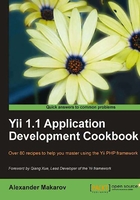
Providing your own URL rules at runtime
When you are developing an application with pluggable module architecture, you most likely need to somehow inject your module-specific rules into an existing application.
Getting ready
- Set up a new application using
yiic webapp. - Add
.htaccess, shown in official URL Management guide to yourwebroot. - Add
'showScriptName' => falseto your URL manager configuration. - Generate the
pagemodule using Gii. - Don't forget to add your new module to the modules list in your application configuration.
The Yii code generator is shown in the following screenshot:

How to do it...
- Create
ModuleUrlManager.phpin yourprotected/componentsdirectory with the following code inside:<?php class ModuleUrlManager { static function collectRules() { if(!empty(Yii::app()->modules)) { foreach(Yii::app()->modules as $moduleName => $config) { $module = Yii::app()->getModule($moduleName); if(!empty($module->urlRules)) { Yii::app()->getUrlManager()->addRules($module->urlRules); } } } return true; } } - In your application configuration, add the following line:
'onBeginRequest' => array('ModuleUrlManager', 'collectRules'), - Now, in your page module, you can add custom rules. To do so, open
PageModule.phpand add:public $urlRules = array( 'test' => 'page/default/index', );
- To test if it works, open your browser and go to
http://example.com/test. This page should look like the one shown in the following screenshot:
This is the view content for action "index". The action belongs to the controller "DefaultController" in the "page" module.
- You still can override URL rules from your main application configuration file. So, what you specify in module's
urlRulesis used only when the main application rules are not matching.
How it works...
Let's review the ModuleUrlManager::collectRules method.
If there are modules defined in our application, then we are checking if urlRules public property exists. If it does, then there are some rules defined in the module and they are added using CUrlManager::addRules.
CUrlManager::addRules description says "In order to make the new rules effective, this method must be called before CWebApplication::processRequest".
Now, let's check how our application works. In our index.php, we have the following line:
Yii::createWebApplication($config)->run();
After being initialized with configuration, we are calling CWebApplication::run():
public function run()
{
if($this->hasEventHandler('onBeginRequest'))
$this->onBeginRequest(new CEvent($this));
$this->processRequest();
if($this->hasEventHandler('onEndRequest'))
$this->onEndRequest(new CEvent($this));
}
As we can see, there is an onBeginRequest event raised just before calling processRequest. That is why we are attaching our class method to it.
There's more...
As instantiating all application modules on every request is not good for performance, it is good to cache module rules. Caching strategy can vary depending on your application. Let's implement a simple one:
<?php
class ModuleUrlManager
{
static function collectRules(){
if(!empty(Yii::app()->modules))
{
$cache = Yii::app()->getCache();
foreach(Yii::app()->modules as $moduleName => $config)
{
$urlRules = false;
if($cache)
$urlRules = $cache->get('module.urls.'.$moduleName);
if($urlRules===false){
$urlRules = array();
$module = Yii::app()->getModule($moduleName);
if(isset($module->urlRules))
$urlRules = $module->urlRules;
if($cache)
$cache->set('module.urls.'.$moduleName, $urlRules);
}
if(!empty($urlRules))
Yii::app()->getUrlManager()->addRules($urlRules);
}
}
return true;
}
}
This implementation caches URL rules per module. So, adding new modules is not a problem but changing existing ones requires you to flush cache manually using Yii::app()->cache->flush().
See also
- The recipe named Configuring URL rules in this chapter